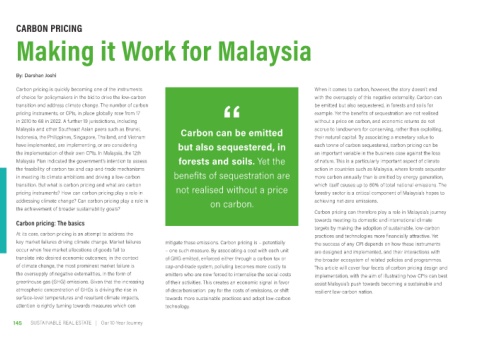Page 156 - GreenRE_Sustainable Real Estate Book
P. 156
CARBON PRICING
Making it Work for Malaysia
By: Darshan Joshi
Carbon pricing is quickly becoming one of the instruments When it comes to carbon, however, the story doesn’t end
of choice for policymakers in the bid to drive the low-carbon with the oversupply of this negative externality. Carbon can
transition and address climate change. The number of carbon be emitted but also sequestered, in forests and soils for
pricing instruments, or CPIs, in place globally rose from 17 “ example. Yet the benefits of sequestration are not realised
in 2010 to 68 in 2022. A further 19 jurisdictions, including without a price on carbon, and economic returns do not
Malaysia and other Southeast Asian peers such as Brunei, Carbon can be emitted accrue to landowners for conserving, rather than exploiting,
Indonesia, the Philippines, Singapore, Thailand, and Vietnam their natural capital. By associating a monetary value to
have implemented, are implementing, or are considering but also sequestered, in each tonne of carbon sequestered, carbon pricing can be
the implementation of their own CPIs. In Malaysia, the 12th an important variable in the business case against the loss
Malaysia Plan indicated the government’s intention to assess forests and soils. Yet the of nature. This is a particularly important aspect of climate
the feasibility of carbon tax and cap-and-trade mechanisms action in countries such as Malaysia, where forests sequester
in meeting its climate ambitions and driving a low-carbon benefits of sequestration are more carbon annually than is emitted by energy generation,
transition. But what is carbon pricing and what are carbon not realised without a price which itself causes up to 80% of total national emissions. The
pricing instruments? How can carbon pricing play a role in forestry sector is a critical component of Malaysia’s hopes to
addressing climate change? Can carbon pricing play a role in on carbon. achieving net-zero emissions.
the achievement of broader sustainability goals?
Carbon pricing can therefore play a role in Malaysia’s journey
Carbon pricing: The basics towards meeting its domestic and international climate
targets by making the adoption of sustainable, low-carbon
At its core, carbon pricing is an attempt to address the practices and technologies more financially attractive. Yet
key market failures driving climate change. Market failures mitigate these emissions. Carbon pricing is – potentially the success of any CPI depends on how these instruments
occur when free market allocations of goods fail to – one such measure. By associating a cost with each unit are designed and implemented, and their interactions with
translate into desired economic outcomes; in the context of GHG emitted, enforced either through a carbon tax or the broader ecosystem of related policies and programmes.
of climate change, the most prominent market failure is cap-and-trade system, polluting becomes more costly to This article will cover four facets of carbon pricing design and
the oversupply of negative externalities, in the form of emitters who are now forced to internalise the social costs implementation, with the aim of illustrating how CPIs can best
greenhouse gas (GHG) emissions. Given that the increasing of their activities. This creates an economic signal in favor assist Malaysia’s push towards becoming a sustainable and
atmospheric concentration of GHGs is driving the rise in of decarbonisation: pay for the costs of emissions, or shift resilient low-carbon nation.
surface-level temperatures and resultant climate impacts, towards more sustainable practices and adopt low-carbon
attention is rightly turning towards measures which can technology.
145 SUSTAINABLE REAL ESTATE | Our 10-Year Journey

